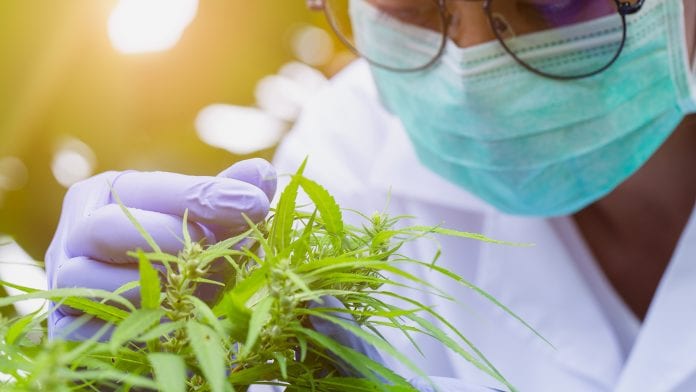
STERO Biotechs produce solutions that are based on novel CBD formulations developed and produced under strict standards.
STERO Biotechs knows that the heated debate on the true effectiveness and safety of medicinal cannabis has been going on for years in the healthcare community, the media, governments, and the public at large.
There is very little scientific evidence to show so far, as it seems that almost no products sold as cannabinoid supplements have been assessed through large, randomised and controlled clinical trials.
This hazy landscape has not deterred consumers from trying CBD-based products, which are now widely available in the US thanks to the 2018 Farm Bill (that removed hemp from the Controlled Substances Act, so that it is no longer considered as a controlled substance under federal law), for almost any ailment. If anything, the use of medical cannabis is becoming increasingly widespread. A simple search on the internet will easily bring up dozens of conditions for which people swear cannabis or CBD can provide pain relief.
The fact that marijuana is still on Schedule I, the most restrictive class, has not helped research in the US. Only three cannabis-based drugs have been approved by the FDA, two with THC and one with CBD only, following some of the possibly very few clinical trials conducted and published to date.
In these particular studies, some issues have already come up, such as more cases of pneumonia and chest infections being reported with CBD than with placebo or pure THC cohorts. In another rare instance where a trial was conducted by the book, a marijuana study suggested a risk of increased myocardial infarction in the first hour after cannabis exposure was twice as high as with Rofexicob, a drug that was eventually removed from the market in 2004.
When looked at methodically, it appears cannabis behaves and should be treated just as any other new drug under development, despite decades, or, one could argue, millennia, of allegedly safe widespread recreational use.
Popular euphoria
The great cannabis hype is everywhere and knows no limits; on any given day, your pedicurist might tell you how she took cannabis that the doctor had prescribed to her mother for her fibromyalgia pain.
Dozens of cannabis related companies are traded in the stock markets. The initial bubble, supported mostly by enthusiastic retail investors, has burst after legalisation in North America did not meet expectations. Canada has not allowed many stores to open, for instance cannabis companies still cannot enjoy even simple banking services, not to mention funding.
Add to that high taxation in the US, with the prospect of an additional federal tax to come if nationwide legalisation materialises, it becomes increasingly harder for legitimate companies to compete against the black market.
Moreover, in the cosemtic industry where so many products now contain some mysterious form and quantity of CBD at least as a marketing gimmick, companies are claiming to do nothing about it. This is because they are not allowed to make any claims without risking the wrath of the FDA.
Still, people are lining up to buy them based mostly on wishful thinking. It is important to note that there are no clinical trials that prove conclusively that CBD has any cosmetic benefits. However, the lack of evidence has not stopped entrepreneurial minds from developing new ideas and uses (it could even be argued that this has perhaps even spurred them on).
In addition to this, CBD has also now been incorperated in other industries such as the food and bervage indsutry (such as patent pending hemp infusion technologies for foods and beverages that will replace alcohol, which claim to ‘provide unparalleled relaxation’), and the sport industry (for instance, a new line of CBD Sport Cream used by many to provide relief of muscle or joint pain will soon be featured at a major sporting goods retail chain in many of its stores across the US).
These products may have fewer adverse effects than opioids, responsible for tens of thousands of deaths each year, but we are not entirely sure what benefits or negative side effects they may have. Athletes claim CBD even improves quality of sleep, however even if this were true, athletes still run a risk that the product they choose to buy does not really contain what it says on the label.
At the next VMX veterinary conference in Orlando, Florida, the world’s largest gathering of veterinary professionals, CBD for pets will be a standing-room-only topic. In addition to this, a chain of cannabis dispensaries have recently celebrated the opening of its 40th store in Florida, boasting the largest selection of CBD and THC products available. However, currently the only kind of regulatory controls in place are for the detection of heavy metals and pesticides, which is the standard procedure for food products.
Another example of what is going on in the cannabis sector is that the Best Ottawa Business Awards for Sales Performance was given to a global video surveillance solutions company. Its sales skyrocketed when it began to target the cannabis market. Their systems provide security for the entire supply chain of vertically integrated cannabis production and distribution customers: cultivation, testing, retail sales and secure delivery, and they also include features that comply with stringent government mandated video surveillance.
RFID (Radio-frequency Identification) tagging from seed to sale is mandated by law, and cannabis operators are required to save the videos for 90 days. The company even sells special software to monitor the health of these video systems. However, what about protecting the health of their human consumers? Such as in relation to the way people ingest and use cannabis based products, and what this does to their bodies and minds. These are important questions to ask as there is hardly any regulation or solid proof of the safety of these medicinal cannabis products.
Major shifts in regulation
Regulators and public health administrators are struggling as their arms are being twisted by popular enthusiasm and irrational consumer demand for something to cure everything. However, some headway is being made in certain areas towards legalisation in the US. For example, in early 2018, the World Anti-Doping Agency (WADA) removed CBD from the list of prohibited substances – in or out of competition. The US Anti-Doping Agency (USADA) did the same. For some reason, only CBD was removed from the prohibited list.
In addition to this, the WHO have recommended removing cannabis from Schedule I, and Schedule IV of the 1961 Single Convention on Narcotic Drugs. The fact that cannabis is in Schedule IV means that scientists who want to investigate the plant in the search for potential therapies face significant barriers. Despite these changes, large scale controlled trials are still necessary to ensure consumer safety and to learn more about the effectiveness of CBD for the various conditions that are being evaluated.
Clinical use
Therapeutic indications for cannabis are assumed to target the endocannabinoid system which have many receptors (CB1, CB2, TRPs, GPRs and more) involved in cognition, memory, analgesia, psychomotricity, appetite, endocrine and immune functions. Despite this however, there is still no hard data available to back up its real safety and effectiveness.
At present, the most serious medically prescribed indications focus on AIDS wasting, epilepsy, neuropathic pain, spasticity associated with multiple sclerosis, as well as cancer and chemotherapy-induced nausea. In these areas, usage is taking place within a proper clinical framework.
The only CBD-based drug to have received FDA approval (for the treatment of seizures associated with two rare and severe forms of epilepsy, Lennox-Gastaut syndrome and Dravet syndrome, in patients two years of age and older) is Epidiolex. Trials indicated it might potentially harm the liver, but if taken under medical supervision this type of risk for patients can be mitigated. This is not possible when people decide to self-medicate or buy CBD Oil of dubious origins.
Perhaps here too, the hype has led to too much credit being given to CBD. In epileptic seizures, frequency or severity of spasticity are symptoms that fluctuate anyhow. Patients who were not suffering a threshold experience at recruitment were excluded, therefore those tested were closer to the profile of the general population.
A plethora of articles have been published about the possibility that smoking marijuana increases the risk of MI in people with cardiovascular conditions. Other articles praise some forms of CBD that seem to be helpful in lowering blood pressure, and as a result, they are actually good for people who were already at risk of MI. The only point on which there is consensus is that more clinical research is needed.
Miracle or ignorance?
There is significant discrepancy between subjective and anecdotal patient reporting vs methodical clinical trials. For example, how do we explain that families of children suffering seizures who moved to Colorado for CBD accessibility, reported more than 50% improvement vs established Colorado residents?
People who take CBD outside formal medical monitoring do so at varying doses of different types of products claiming to contain various components with multiple forms of ingestion, and may be suffering from other conditions in parallel. Drug to drug interactions (DDIs) and adverse events (ADEs) do not seem to happen. Either this is a miracle or such incidents are simply grossly under-reported.
To add to the confusion, many patients are too embarrassed to admit to their doctors that they are using illegal substances. In addition, there is always the issue of placebos. On trial work done for THC-based Marinol and Syndros, which are now FDA approved, one of the problems found was that blind testing was difficult because patients could feel the effect.
Though the FDA’s December 2016 Guidance for Industry: Botanical Drug Development provides specific recommendations on submitting INDs for botanical drug products, such as those derived from cannabis, in support of future marketing applications for these products, the institution receives very limited reports on adverse effects of cannabis. In short, the high publicity and CBD frenzy appear to have created unrealistically high expectations that only real large scale controlled studies will be able to confirm.
How safe are we?
Although in some areas CBD seem to be generally safe in the broader healthy population, it can be harmful to some groups (such as young adults, women of childbearing age, pregnant women, children, and the elderly). For example, it may cause hormonal changes or imbalances that could have repercussions on fertility, or bring on early labour in pregnancy.
Contrary to popular belief and anecdotal evidence, CBD is not a biologically inert compound. Rather, CBD has a complex pharmacokinetic and pharmacodynamics profile similar to any other medication with the potential to interact with other medications and medical conditions. CBD has been found to impede the activity of certain enzymes found in the liver, such as the cytochrome P450 enzyme system (particularly CYP3A4), that metabolises pharmaceutical drugs meant for human consumption.
According to Davis’s Drug Guide, the P450 enzyme system contains more than 50 enzymes that process and eliminate toxins. If taken in high doses, CBD oil can completely neutralise P450 enzyme’s activity, as this cannabinoid requires the same enzyme to be metabolised. Therefore, when CBD is taken concomitantly with other medications this may keep them from acting as intended, greatly reducing their effectiveness, and potentially causing harm.
In addition, CBD oil can have negative side effects, such as drowsiness, drop in blood pressure when taken in large doses, being potentially harmful for people with low blood pressure. Other problems are dizziness or light-headedness, appetite changes, diarrhoea, hormonal changes, hypokinesia and resting tremor when used for epilepsy.
In psychotic disorders it has side effects too, but they are milder than on other drugs used until today. It can benefit some Parkinson’s patients, but not all of them.
Some athletes claim that CBD can keep them off NSAIDS for exercise related pain. But there’s practically no scientific proof that a CBD-infused topical cream is any more effective than other topical pain relievers that have been available for decades at a drugstores and pharmacies.
CBD’s analgesic and anti-inflammatory properties do seem to provide relief in many cases, such as with psoriasis, joint or muscle pain. However, it should be noted that all this is subject to the type of pain, as well as the dose and modes of administration.
Finding a happy medium
Recreational or consumer CBD users should be much more cautious with what they use and ingest. Medical CBD users under clinical supervision should be screened for potential DDIs and ADEs between CBD, other pharmacotherapies, and their underlying conditions. At the same time, healthcare providers who are more aware of the potential for DDIs and ADEs with CBD and strategically prescribe and manage patient regimens, should also consider patient quality of life and their requests for complementary or alternative therapies.
Moreover, Israeli companies such as STERO Biotechs, CannaLean Biotechs and CannaMore Biotechs, understand these problems and are developing better solutions, based on novel CBD formulations developed and produced under strict standards. Research and conclusions are based on solid preclinical and clinical studies, and an overall FDA-oriented development.
STERO Biotechs is committed to the research and development of novel and improved cannabidiol (CBD)-based drugs for steroid–sparing therapy in a great number of medical indications that could potentially benefit millions of patients, focusing mainly on inflammatory and autoimmune diseases. The company aims to develop products that will not only reduce side effects but also the need for steroid therapy, whilst at the same time increasing the effectiveness of steroid treatment in patients.
STERO is now performing clinical trials in various indications such as autoimmune hepatitis, steroid-dependent Crohn’s disease and chronic Urticaria. Prolonged use of steroids can result in a variety of serious side effects. Physicians may prescribe the use of CBD-based medications in order to significantly reduce the dose taken by patients or to get them off steroids altogether, while preventing a flare of their disease. In fact, while conducting studies on severe acute GVHD (Graft vs Host Disease) in patients treated with steroids, it was discovered that a significant reduction in the use of steroids became possible when CBD was administered to the patient.
Moreover, 90% of the patients in the study showed a significant positive response to the therapy. These striking results led to the idea of investigating the potential effects CBD therapy might have on steroid-dependent patients with autoimmune or inflammatory disease, and thus STERO was founded.
Some of the people behind STERO Biotechs are Mr David Bassa, Dr Moshe Yeshurun, and Dr Sari Prutchi Sagiv, the former leaders of Talent Biotechs. Talent Biotechs, one of the few companies in the world conducting FDA oriented CBD-based drug development clinical trials since 2011, which they established and managed up to its $40m (~€36.3m) acquisition by Kalytera Therapeutics TSXV: KALY in 2017. Kalytera, on its part, continues its work through extensive clinical trials with the objective of obtaining FDA approval for use in the prevention and treatment of GVHD.
More research is necessary before clinical evidence can conclusively show which cannabinoids are best for each indication, their mode of administration, and correct dose.
Eventually, if regulators manage to set the right framework that can foster efficient research and development work by the medical community and serious cannabis-related companies, all these avenues will be investigated methodically and a balance will be reached. Patients should have the right to use substances or medications that can help them, regardless of politics or historical issues. However, they should also be kept safe and assured of effectiveness – it’s a fine line.
Dr Sari Prutchi Sagiv
CSO
STERO Biotechs
+972 3 6176173
mail@STERObiotechs.com
STERObiotechs.com
This article will appear in the first issue of Medical Cannabis Network which will be out in January. Click here to subscribe.









